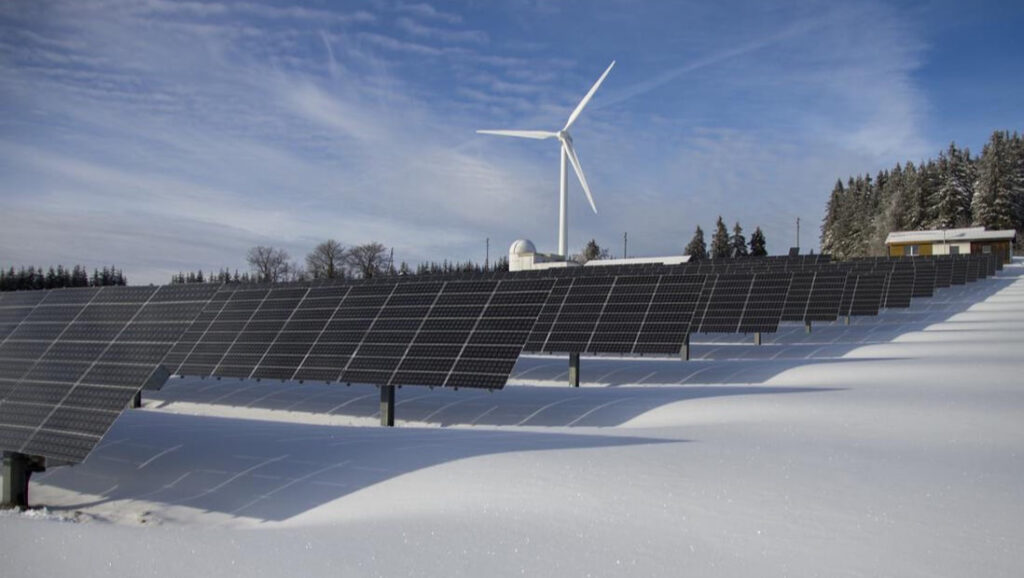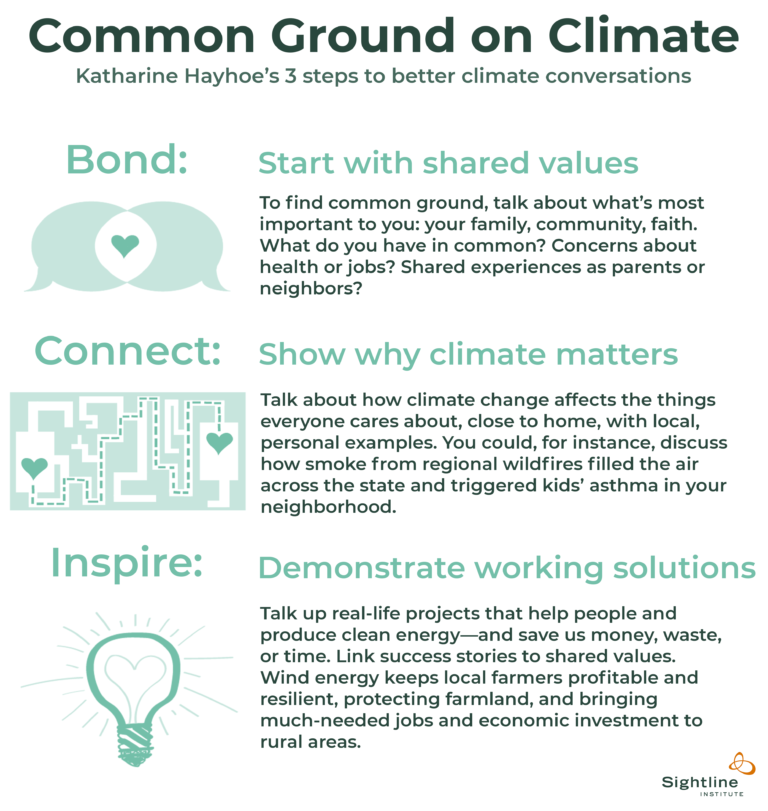

Written by Aven Frey. Republished from Sightline Institute with permission.
Esteemed climate communicator Dr. Katharine Hayhoe is back on the lecture circuit with a new talk, which I was lucky enough to catch at the University of Washington in mid-May. Dr. Hayhoe’s life and credentials make her uniquely suited to bridge divides and speak from the heart about climate science: She’s a Canadian expat in Texas, an atmospheric scientist and political scientist at Texas Tech, and an Evangelical Christian. She’s produced a trove of stellar science and messaging resources. We’ve shared her climate communication tips before, and her message hasn’t changed: Climate change is real. It’s us. It’s bad. And there are all kinds of solutions.
But conversations about climate aren’t always so simple.
Increasing numbers of Americans, liberal and conservative, say they are worried about climate change, but too many (including plenty of the people in charge, elected or otherwise) are in different stages of complacency or compartmentalization—or denial. Dr. Hayhoe says the best thing we can do is talk about climate change more with people we know—and in personal terms. She reminds us to start with values, not facts. Piling on more facts and data doesn’t work and can even backfire. Why?
“Because when it comes to climate change,” she wrote recently in Science, ”science-y sounding objections are a mere smokescreen to hide the real reasons, which have much more to do with identity and ideology than data and facts.”
When people feel that the policy solutions challenge their fundamental beliefs (government regulations, taxes, or restrictions on consumption), it’s easier to find a way to reject the science. In fact, the best predictor of whether a person acknowledges the reality of human-caused global warming is their political identity, not their scientific knowledge.
Partisanship compounds other barriers. For some, there’s a sense that “only a certain kind of person” cares about climate change. Numbers are growing, but many Americans aren’t aware of the scientific consensus about man-made climate change (a powerful “gateway belief” that could move the needle on other climate attitudes.) For others, feeling there’s nothing we can do about it can lead to apathy or paralysis. This
number is growing too, but most Americans don’t think climate impacts will affect them personally.
So, where to begin? According to Dr. Hayhoe, one of the most powerful things we as individuals can do to fight climate change is simple–talk to people about climate change. The truth is that most Americans rarely discuss global warming themselves and a majority say they hear little about it in the media.
Dr. Hayhoe challenges all of us to have more climate conversations. Here’s her three-part formula for relevant, constructive, and hopeful climate talk.
BOND
First, says Dr. Hayhoe, find common ground. In other words, start by finding values, concerns, and experiences you share (not with a barrage of facts and figures).
“As uncomfortable as this is for a scientist in today’s world,” Dr. Hayhoe writes, “the most effective thing I’ve done is to let people know that I am a Christian. Why? Because it’s essential to connect the impacts of a changing climate directly to what’s already meaningful in one’s life, and for many people, faith is central to who they are.”
Religious or not, she reminds us that “nearly every human on the planet already has the values they need to care about climate change.” She suggests finding genuine ways to connect with others—bonding over a shared love of gardening or health concerns or a shared interest in national security. Building trust helps breaks down walls built up by partisanship.
CONNECT
Find personal, relevant ways to show why climate matters. Dr. Hayhoe suggests connecting heart to head: talk about how climate change matters to the people and places we care about. Help people see how the science relates to your shared everyday experiences. It’s not about polar bears and ice caps—it’s about us, right here at home. Talk about local climate impacts and what they’ve meant for real people.
For example, Dr. Hayhoe knows her Texan neighbors are acutely aware of the devastating impacts of drought on their state, and since climate change is making droughts more severe, she links the science to their existing concerns. You could talk about health problems exacerbated by heat or pollution. Or maybe you both like the same Northwest brews—climate change affects beer, too!
INSPIRE
Demonstrate how real-life climate solutions are working. If we only talk about the daunting challenge of climate change or the difficult impacts without offering hopeful solutions, Dr. Hayhoe warns, then people’s natural defense mechanism is to disassociate from the reality of the problem. To change minds and bring people aboard, we can’t forget this third step: inspiring with practical, viable, and attractive solutions. People get excited about technology and efficiency. In fact, seven out of 10 Americans support prioritizing renewable energy like wind and solar, over oil, coal, and natural gas, according to an April 2018 Gallup poll. But most of us don’t necessarily know about solutions working for people and communities in our neighborhood or our state. When you’re talking about solutions, your conversation isn’t about science anymore, but about working together to solve this problem in ways that resonate with the shared values you’ve established.
For example, Dr. Hayhoe capitalizes on Texas state pride, and gets people’s attention by pointing out that the state is already a leader in wind energy production (and if you don’t believe they take pride in this, check out the title of the linked article), and boasting that three of the nation’s top ten cities for solar power potential are in Texas. Dr. Hayhoe knows people in her neighborhood not only admire her efficient plug-in electric car once they know how much money she saves on gas, but love the idea of taking advantage of Texas’ vast wealth of renewable energy potential to save Texas families money on energy bills and taxes, and to create local jobs, and help to ease the devastating droughts made longer and more severe by a changing climate.
These three steps make for easier, more powerful climate conversations. And Dr. Hayhoe challenges us all to go out and have those conversations! When you’re ready to try it out for yourself, here’s our cheat sheet:




Leave a Reply